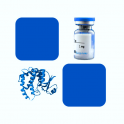
- Remove this product from my favorite's list.
- Add this product to my list of favorites.
Products
Viewed products
Newsletter
 |  |  |  |  |  |

Background
Integrin alpha IIb beta 3 exist in a conformational equilibrium clustered around four main states. These conformations range from a compact bent nodule to two partially extended intermediate conformers and finally to a fully upright state. Activation of blood platelets by physiological stimuli at sites of vascular injury induces inside-out signaling, resulting in a conformational change of the prototype Integrin alpha IIb beta 3 from an inactive to an active state competent to bind soluble fibrinogen. Furthermore, ligand occupancy of Integrin alpha IIb beta 3 outside-in signaling and additional conformational changes of the receptor, leading to the exposure of extracellular neoepitopes termed ligand-induced binding sites (LIBS), which are recognized by anti-LIBS monoclonal antibodies.
Source
Recombinant Human ITGAIIb&ITGB3 Heterodimer Protein,His Tag&Tag Free (IT3-H52W8) is expressed from human 293 cells (HEK293). It contains AA Leu 32 - Arg 993 (ITGAIIb) & Gly 27 - Asp 718 (ITGB3) (Accession # P08514-1(ITGAIIb) & P05106-1(ITGB3)).
Predicted N-terminus: Leu 32 (ITGAIIb) & Gly 27 (ITGB3)
Molecular Characterization
Human ITGAIIb&ITGB3 Heterodimer Protein, His Tag&Tag Free, produced by co-expression of ITGAIIb and ITGB3, has a calculated MW of 111.4 kDa (ITGAIIb) and 81.8 kDa (ITGB3). Subunit ITGAIIb is fused with an acidic tail at the C-terminus and followed by a polyhistidine tag and subunit ITGB3 contains no tag but a basic tail at the C-terminus. The non-reducing (NR) protein migrates as 115-130 kDa (ITGAIIb) and 85-92 kDa (ITGB3) respectively due to glycosylation.
Endotoxin
Less than 1.0 EU per μg by the LAL method.
Purity
>90% as determined by SDS-PAGE.
Formulation
Lyophilized from 0.22 μm filtered solution in 50 mM Tris, 150 mM NaCl, pH7.5 with trehalose as protectant.
Reconstitution
Please see Certificate of Analysis for specific instructions.
For best performance, we strongly recommend you to follow the reconstitution protocol provided in the CoA.
Storage
For long term storage, the product should be stored at lyophilized state at -20°C or lower.
Please avoid repeated freeze-thaw cycles.
No activity loss was observed after storage at:
This product is stable after storage at:
-20°C to -70°C for 12 months in lyophilized state;
-70°C for 3 months under sterile conditions after reconstitution.
Bioactivity
Please refer to product data sheet.
(1) "Atp6v1h Deficiency Blocks Bone Loss in Simulated Microgravity Mice through the Fos-Jun-Src-Integrin Pathway"
Zhao, Wang, Ma et al
Int J Mol Sci (2024) 25 (1)
(2) "Prostate cancer cell-platelet bidirectional signaling promotes calcium mobilization, invasion and apoptotic resistance via distinct receptor-ligand pairs"
Garofano, Rashid, Smith et al
Sci Rep (2023) 13 (1), 2864
(3) "Differential Surface Engineering Generates Core-Shell Porous Silicon Nanoparticles for Controlled and Targeted Delivery of an Anticancer Drug"
Zhang, Tieu, Esser et al
ACS Appl Mater Interfaces (2022) 14 (49), 54539-54549
Showing 1-3 of 41 papers.
Follow us